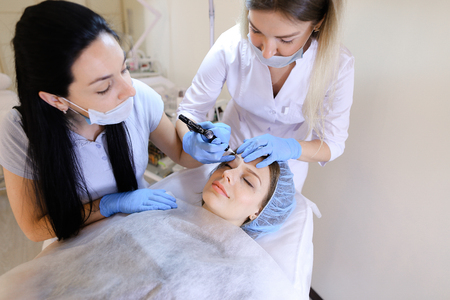1. Introduction to Dermal Fillers
Dermal fillers have swiftly become one of the most sought-after cosmetic treatments across the UK, capturing the attention of individuals keen on maintaining a youthful appearance without resorting to surgical procedures. These injectable gels are carefully formulated to restore volume, smooth out lines, and enhance facial contours, offering a subtle yet effective transformation. Their popularity is not only fuelled by their minimally invasive nature but also by the promise of quick results and minimal downtime. In British culture, where a natural and refreshed look is often prized over drastic alterations, dermal fillers have carved out an important role in non-surgical facial rejuvenation. They empower people to address concerns such as fine lines, loss of volume, and sagging skin—helping them feel more confident and comfortable in their own skin while preserving their unique features.
2. The Science Behind Dermal Fillers
Dermal fillers have gained popularity across the UK as a safe and effective solution for non-surgical facial rejuvenation, but what exactly makes them work so well? The secret lies in their scientifically formulated ingredients, most notably hyaluronic acid, which is naturally present in our skin. Hyaluronic acid acts like a sponge, drawing in and retaining moisture to keep our skin plump and hydrated. As we age, natural levels of this molecule decline, leading to loss of volume and elasticity. By carefully reintroducing hyaluronic acid through dermal fillers, practitioners are able to restore youthful contours and smooth out fine lines.
Key Ingredients in Dermal Fillers
| Ingredient | Source | Main Function |
|---|---|---|
| Hyaluronic Acid | Biotechnologically produced or animal-derived | Hydration & volume restoration |
| Calcium Hydroxylapatite | Synthesised mineral compound | Stimulates collagen production, adds structure |
| Poly-L-lactic Acid | Synthetic polymer | Gradually boosts collagen synthesis |
| Polymethylmethacrylate (PMMA) | Synthetic microspheres in collagen gel | Long-lasting structural support |
How Fillers Interact with Skin Tissues
The biological magic begins once these fillers are injected beneath the skin’s surface. Hyaluronic acid-based fillers bind water molecules within the tissue, instantly restoring lost volume and giving the complexion a refreshed appearance. Over time, ingredients such as calcium hydroxylapatite and poly-L-lactic acid stimulate the body’s own collagen production mechanisms. Collagen is a crucial protein that provides strength and structure to the skin, and its increased presence means firmer, more resilient skin even after the initial filler has been absorbed.
The Biological Basis for Effectiveness
The effectiveness of dermal fillers comes down to their compatibility with our biology. Because key ingredients like hyaluronic acid are already found within our bodies, there’s minimal risk of adverse reactions when administered by trained professionals. The gradual breakdown of these substances also ensures that results fade softly over time rather than disappearing suddenly. This seamless integration with our skin’s natural processes allows for subtle yet significant enhancements—perfectly suited to British preferences for understated elegance and a natural look.

3. Popular Types of Fillers Used in the UK
When it comes to non-surgical rejuvenation, British clients and practitioners have a clear set of favourites among dermal fillers, thanks to their proven safety, effectiveness, and natural-looking results. The most commonly used fillers in the UK are based on hyaluronic acid (HA), a substance naturally found in our skin that helps maintain hydration and volume. Leading brands such as Juvéderm, Restylane, and Teosyal are highly regarded for their versatility and reliability. These HA fillers are especially popular for smoothing fine lines, plumping lips, and restoring lost facial volume, all while allowing for subtle enhancements that suit British preferences for understated elegance.
In addition to hyaluronic acid-based options, some UK clinics also offer fillers made from calcium hydroxylapatite—most notably Radiesse. This type of filler is often chosen for its ability to stimulate collagen production and provide longer-lasting structural support, making it ideal for deeper wrinkles and contouring areas such as the cheeks or jawline. While less common, poly-L-lactic acid fillers like Sculptra are available for those seeking gradual, natural improvement over time.
The popularity of these specific brands and substances reflects a shared commitment across the UK aesthetic industry: to deliver safe, predictable, and beautifully subtle results that enhance rather than transform one’s appearance. Skilled practitioners carefully select the most appropriate filler according to each client’s unique needs and desired outcomes—always prioritising a look that feels authentically you.
4. How Dermal Fillers Transform Appearance
Dermal fillers have become a mainstay in British clinics, celebrated for their ability to deliver subtle yet striking enhancements without the need for invasive surgery. But what is it about these clever gels that can so artfully turn back the clock? The answer lies in their unique capacity to restore lost volume, smooth out wrinkles, and revive facial contours in a way that feels entirely natural.
The Science of Volume Restoration
Our faces naturally lose subcutaneous fat and collagen as we age, leading to hollowed cheeks, sagging skin, and more pronounced lines. Dermal fillers, most commonly formulated with hyaluronic acid—a substance found naturally in our bodies—are carefully injected into targeted areas. The filler attracts water molecules, plumping up the skin from within and replacing the volume thats been lost over time.
Smoothing Lines and Enhancing Features
In British clinics, clients often seek treatment for nasolabial folds (the lines running from nose to mouth), marionette lines, or thinning lips. Fillers work by physically lifting the skin and supporting underlying structures, thereby softening deep creases and providing a smoother canvas. This action is both immediate and progressive; while you may notice an instant improvement, results continue to refine as the filler integrates with your own tissue.
Real-World Effects Observed in UK Clinics
| Treated Area | Common Concerns | Observed Results |
|---|---|---|
| Cheeks | Loss of fullness, sagging | Restored youthful contour and lift |
| Lips | Thinning, loss of definition | Enhanced shape and volume; natural-looking fullness |
| Under Eyes (Tear Troughs) | Dark circles, hollowness | Smoother under-eye area; brighter appearance |
| Jawline & Chin | Lack of definition, jowls | Crisper profile; improved structure |
This table illustrates just how versatile dermal fillers can be in addressing a wide range of concerns typically seen across the UK. Whether it’s a subtle tweak or a more noticeable transformation, each result is tailored to harmonise with one’s natural features—ensuring you still look like yourself, only fresher.
Ultimately, the magic of dermal fillers lies in their science-backed ability to restore what time has taken away. With skilled hands and a nuanced approach, practitioners across Britain are helping people rediscover confidence through safe and effective non-surgical rejuvenation.
5. Safety, Standards, and What to Expect
When considering dermal fillers for non-surgical rejuvenation, understanding the safety measures and standards in place is absolutely essential—especially in the UK, where regulations are designed with your wellbeing at heart. The British approach to dermal fillers is rooted in stringent guidelines set by bodies such as the General Medical Council (GMC) and the Care Quality Commission (CQC), ensuring that only qualified professionals administer these treatments.
Rigorous Regulation for Peace of Mind
The UK has made significant strides in tightening controls around aesthetic treatments. Unlike many countries, practitioners offering dermal fillers must adhere to strict protocols regarding training and hygiene. This includes a thorough knowledge of facial anatomy, safe injection techniques, and emergency procedures should complications arise. Clinics are expected to maintain clinical standards akin to those found in medical environments, so you can feel reassured about cleanliness and professionalism.
Choosing a Qualified Practitioner
Your results—and your safety—depend greatly on who performs your treatment. It’s vital to select a practitioner registered with an appropriate regulatory body such as the GMC, the Nursing and Midwifery Council (NMC), or the General Dental Council (GDC). Don’t hesitate to ask about their training, experience with fillers, and see evidence of their previous work. Trustworthy clinics will happily provide this information.
What You Can Expect During Your Appointment
A reputable practitioner will begin with a detailed consultation, assessing your goals and suitability for dermal fillers. They’ll explain the procedure, potential side effects, and aftercare advice clearly—there’s no such thing as a silly question when it comes to your health. On the day, you can expect meticulous attention to hygiene and comfort throughout your treatment. Following up post-procedure is standard practice; it’s part of what makes the UK approach so reliable.
Ultimately, choosing dermal fillers in Britain means benefiting from robust safety frameworks and high professional standards. By seeking out experienced practitioners who operate within these guidelines, you’re placing yourself in safe hands—so you can look forward to refreshed confidence with total peace of mind.
6. Natural Results: British Aesthetic Preferences
Within the UK, there is a distinctive approach to aesthetic treatments that sets it apart from other regions of the world. The British preference leans heavily towards subtlety and authenticity—individuals typically desire enhancements that look effortlessly natural, rather than dramatically altered. This cultural inclination shapes not only the demand for dermal fillers but also how practitioners deliver these treatments.
British clients often seek to maintain their unique features while gently addressing signs of ageing or volume loss. The goal is to look refreshed and well-rested, never overdone or conspicuously “treated.” As a result, skilled practitioners in the UK place emphasis on using filler products that integrate smoothly with the natural contours of the face, prioritising techniques that enhance rather than transform.
The Science Meets Subtlety
The advanced formulations used in modern dermal fillers—many of which are based on hyaluronic acid—are designed to mimic the skin’s own supportive structures. This compatibility allows for delicate corrections and gradual improvements, aligning perfectly with the understated British aesthetic. Practitioners select specific filler types and injection depths tailored to each person’s facial anatomy and desired outcome, ensuring results are harmonious with their natural appearance.
Personalised Approaches
Consultations within UK clinics tend to be highly personalised. Practitioners spend time understanding not just the client’s physical features but also their lifestyle and personal preferences. This collaborative approach ensures that enhancements remain discreet, allowing individuals to feel more confident without sacrificing their authentic selves.
Impact on Filler Choice
The popularity of minimally invasive, reversible fillers further reflects these values. Temporary fillers are favoured for their safety profile and adaptability, giving clients peace of mind and control over their look. Ultimately, this measured philosophy has helped foster trust in non-surgical rejuvenation options across Britain, making dermal fillers a preferred choice for those who wish to age gracefully and naturally.
7. Conclusion: Embracing Confidence through Science-Backed Enhancement
Dermal fillers have truly transformed the landscape of non-surgical rejuvenation, offering a safe and effective way for individuals to refresh their appearance without resorting to invasive procedures. As we have explored, these treatments are deeply rooted in scientific innovation, harnessing naturally occurring substances such as hyaluronic acid to restore volume and smoothness to the skin. The benefits extend well beyond aesthetics—many people find that their self-confidence flourishes when they look and feel their best.
Rest assured, dermal fillers are stringently regulated across the UK, with practitioners adhering to rigorous safety standards and utilising clinically proven techniques. When administered by a qualified professional, the risks are minimal and the results can be beautifully subtle and natural-looking. This commitment to safety and efficacy should provide peace of mind for anyone considering treatment.
Ultimately, the decision to pursue non-surgical enhancement is a personal one. By understanding the science behind dermal fillers and seeking guidance from reputable experts, you empower yourself to make an informed choice that aligns with your individual goals and values. Remember, embracing aesthetic treatments is not about changing who you are—it’s about enhancing your confidence and celebrating your unique beauty, backed by advances in modern science.


